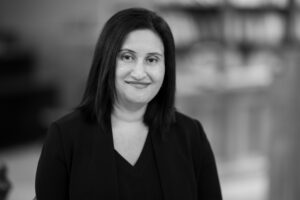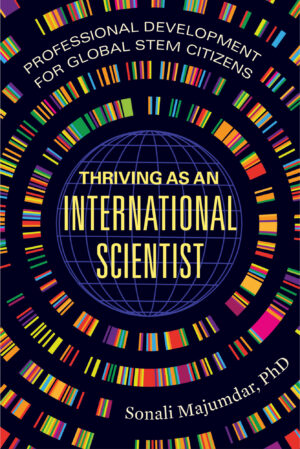Q&A with Sonali Majumdar, author of "Thriving as an International Scientist"

For foreign-born scientists holding temporary visas in the US, building a career while navigating the antiquated and restrictive American immigration system takes resilience and creativity. In this book, Sonali Majumdar, a fellow immigrant scientist and a professional development advisor for international doctoral students in engineering and the natural sciences, shares her expertise of how international scientists can be empowered to flourish in any career.
Unlike other professional development guides, Thriving as an International Scientist foregrounds the unique needs and skills of immigrant STEM PhDs at all career stages and across diverse sectors. Through recommendations for best practices of professional development and career design as well as stories of international scientists, this book also provides concrete, culturally appropriate tools for managers, faculty advisors, and other mentors. With a combination of hard-nosed advice and nurturing encouragement, Majumdar delivers a much-needed guide to help these often overlooked scientists forge a successful career path.
Sonali Majumdar's non-linear career is grounded in curiosity and a penchant for solving complex problems, undeterred by constraints. At present, she is assistant dean for professional development at the Graduate School of Princeton University. Previously, she was Associate Director of Graduate Professional Development at University of Virginia. A scientist by training, she builds innovative professional development programs and multi-sector partnerships to empower PhDs to solve complex socio-scientific problems through dynamic careers. Since 2018, she has developed two field-leading PhD-level professional development programs, PhD Plus at University of Virginia and GradFUTURES at Princeton University. Determined to make systemic improvement and data-informed decisions, she directs Princeton Graduate School’s efforts in tracking long-term career outcomes of graduate alumni and served as administrative lead for the UVA’s pilot of AAU PhD Education Initiative. Born and raised in India, Sonali earned a PhD in biochemistry and molecular biology from the University of Georgia followed by postdoc training in Memorial Sloan Kettering Center. Sonali is a passionate advocate for professional development of international graduate students and postdocs in the United States. More at sonalimajumdar.com.

What should international STEM graduate students and postdoc researchers in the US understand about building a career? Can international students still thrive in the US?
International graduate students and postdocs in the U.S. face a paradox: they drive cutting-edge research while navigating restrictive immigration policies. Too often, this forces them into deficit thinking—choosing careers based on visa feasibility rather than ambition. To thrive, they must bring the same skills they use in science—curiosity, creativity, problem solving, and risk-taking—into their careers. In today’s climate of rising anti-immigrant sentiment and threats to research funding in the US, exploring global career opportunities is also a wise choice. Ultimately, international scientists trained in US universities are invaluable assets, blending rigorous scientific training with resilience, global perspectives, and an innovative spirit that enriches every workplace.
Your passion as a scientist led you to build “holistic” PhD and postdoc training to “empower socially engaged, dynamic and creative academics” Why?
My passion for solving complex problems shaped both my research and my career. As a PhD and postdoc scientist, I was struck by the gap between the expectation that young scientists drive innovation and the lack of training that prepared us for diverse careers to tackle complex socioscientific problems. This disconnect not only risks opportunity costs of wasting talent and dulling ambitions but also undermines scientists’ wellbeing. Inspired by national efforts to track PhD career outcomes and close training gaps—such as the NIH Broadening Experience in Scientific Training (BEST) awards—I was motivated to build professional development programs and cross-sector partnerships that connect early-career scientists to broader career opportunities and emerging challenges. I wish these professional development programs had existed for me and my peers. Ultimately, the most effective way to demonstrate the value of a PhD is by empowering scientists to become leaders and positive influences across a wide range of fields.
You began writing this book in 2023? What are the biggest changes for international graduate students heading into fall 2025?
I wrote this book in 2023–24, highlighting long-overdue immigration reforms critical to international scientists’ training and careers in the U.S. as well as scientific workforce needs. While there were modest improvements under the Biden administration, the landscape has shifted dramatically. In just the first half of 2025, the second Trump administration has created an environment of intense fear and uncertainty: threatening universities’ ability to recruit international students, revoking visas without notifying university officials, pausing visa appointments in summer impacting fall enrollments, and openly calling for reduced international student enrollment. New proposals would potentially impose fixed duration of status on student visas (requiring regular extensions to complete PhD) and eliminate Optional Practical Training, which allows STEM graduates of US universities to gain vital work experience. These measures don’t just disrupt students’ lives—they actively drive talent away, putting America’s leadership in science and technology at risk.
How can advisers and mentors better support international graduate students and postdocs?
Advisers and mentors can best support international graduate students and postdocs by first understanding the visa-related restrictions, cultural and professional differences, and systemic challenges they face—so their brilliance isn’t limited by barriers beyond their control. They can help mentees creatively identify opportunities within these constraints, clarify unwritten professional norms, and connect them with resources across campus. No single mentor can do it all, so collaboration with the Graduate School, Postdoc Office, International Student and Scholar Services, and Career Centers is key. Encourage mentees to build a team of mentors and connect them with alumni in diverse careers worldwide. Above all, even without knowing details, be a steady source of support—international scientists are resourceful; they just need to know their mentors are in their corner.
How are you advising graduate students about the uncertainties of the current job market?
I encourage emerging scientists to approach career planning like their research—designing parallel future paths and testing scenarios, much like troubleshooting experiments by changing a variable. In my book, I introduce a creative design framework for planning multiple futures adapted from Designing Your Life by Bill Burnett and Dave Evans. This approach requires clarity of purpose, awareness of global workforce trends and emerging fields, and a strong network of PhDs thriving in diverse careers. I urge graduate students to use professional development programs and university resources to build in-demand skills, and to focus less on specific jobs and more on unsolved problems and emerging fields. The enduring value of a PhD lies in creative problem-solving, self-directed learning, and discovery—skills that translate across careers. Just as importantly, they must learn to communicate that broad value to employers, presenting themselves as dynamic problem solvers and innovators, not just domain experts.